Xuande Emperor
The Xuande Emperor (16 March 1399[1] – 31 January 1435), personal name Zhu Zhanji (朱瞻基), was the fifth emperor of the Ming dynasty, reigned from 1425 to 1435. His era name "Xuande" means "proclamation of virtue". Ruling over a relatively peaceful period within Ming history, he was also personally fond of painting and literature. The Emperor ordered tax reductions on burdened farmers and attempted to purge corruption from the revenue collectors. His attempts to reform meritocracy within the military were unsuccessful, and he was forced to recognize the independence of Vietnam when the Mongol threat diverted his attention.[2]
| Xuande Emperor 宣德帝 | |||||||||||||||||
|---|---|---|---|---|---|---|---|---|---|---|---|---|---|---|---|---|---|
 | |||||||||||||||||
| Emperor of the Ming dynasty | |||||||||||||||||
| Reign | 27 June 1425 – 31 January 1435 | ||||||||||||||||
| Enthronement | 27 June 1425 | ||||||||||||||||
| Predecessor | Hongxi Emperor | ||||||||||||||||
| Successor | Emperor Yingzong (Zhengtong Emperor) | ||||||||||||||||
| Crown Prince of the Ming dynasty | |||||||||||||||||
| Tenure | 1 November 1424 – 27 June 1425 | ||||||||||||||||
| Predecessor | Crown Prince Zhu Gaochi | ||||||||||||||||
| Successor | Crown Prince Zhu Qizhen | ||||||||||||||||
| Imperial Grandson-heir of the Ming dynasty | |||||||||||||||||
| Tenure | 1411–1424 | ||||||||||||||||
| Predecessor | Imperial Grandson-heir Zhu Yunwen | ||||||||||||||||
| Born | 16 March 1399 Hongwu 32, 9th day of the 2nd month (洪武三十二年二月初九日) Beijing, Ming dynasty | ||||||||||||||||
| Died | 31 January 1435 (aged 35) Xuande 10, 3rd day of the 1st month (宣德十年正月初三日) Palace of Heavenly Purity, Forbidden City, Beijing, Ming dynasty | ||||||||||||||||
| Burial | Jingling Mausoleum, Ming tombs, Beijing | ||||||||||||||||
| Consorts | |||||||||||||||||
| Issue |
| ||||||||||||||||
| |||||||||||||||||
| House | Zhu | ||||||||||||||||
| Dynasty | Ming | ||||||||||||||||
| Father | Hongxi Emperor | ||||||||||||||||
| Mother | Empress Chengxiaozhao | ||||||||||||||||
| Xuande Emperor | |||||||||||||||||||||||||
|---|---|---|---|---|---|---|---|---|---|---|---|---|---|---|---|---|---|---|---|---|---|---|---|---|---|
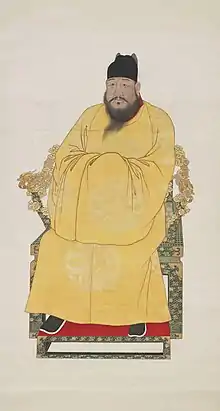 | |||||||||||||||||||||||||
| Chinese | 宣德帝 | ||||||||||||||||||||||||
| |||||||||||||||||||||||||
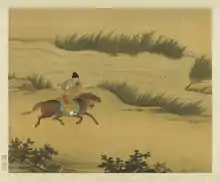

Biography
Zhu Zhanji was the eldest son of the Hongxi Emperor and Empress Chengxiaozhao. He was described as a crown prince who was endowed with the quality of an excellent monarch in a section of his biography surrounded by superstition. His grandfather, the Yongle Emperor, had high hopes that he might play an important part to assist his father.[3]
He was fond of poetry and literature. Although he continued to refer to Beijing as the secondary capital on all official documents, he maintained it as his residence and continued to rule there in the style of his grandfather, the Yongle Emperor. He permitted Zheng He to lead the seventh and last of his maritime expeditions.
The Xuande Emperor's uncle, Zhu Gaoxu, Prince of Han had been a favorite of the Yongle Emperor for his military successes, but he disobeyed imperial instructions and in 1417 had been exiled to the small fief of Le'an in Shandong. When Zhu Gaoxu revolted, the Xuande Emperor took 20,000 soldiers and attacked him at Le'an. Zhu Gaoxu surrendered soon afterward, was reduced to the status of a commoner. Six hundred rebelling officials were executed, and 2,200 were banished. The emperor did not wish to execute his uncle at the start, but later events angered the emperor so much that Zhu Gaoxu was executed through fire torture. All his sons were executed as well. It is very likely that Zhu Gaoxu's arrogance, well detailed in many historic texts, offended the emperor. A theory states that when the emperor went to visit his uncle, Zhu Gaoxu intentionally tripped him.
In 1428, the Xuande Emperor granted King Hashi of Chūzan the family name Shang (尚, Shō in Japanese), gave him the title of Liuqiu Wang (琉球王, Ryūkyū-Ō in Japanese, lit. 'King of Ryūkyū'), and gifted him a red lacquered tablet with Chung Shan (中山, Chūzan in Japanese) inscribed in gold, which was then placed on the Chūzonmon gate near Shuri Castle.[4]
The Xuande Emperor wanted to withdraw his troops from Việt Nam, but some of his advisors disagreed. After Ming garrisons suffered heavy casualties, the emperor sent Liu Sheng with an army. These were badly defeated by the Vietnamese. The Ming forces withdrew and the Xuande Emperor eventually recognized the independence of Việt Nam. In the north, the Xuande Emperor was inspecting the border with 3,000 cavalry troops in 1428 and was able to retaliate against a raid by the Mongols of the Northern Yuan. The Ming government let Arughtai's Eastern Mongols battle with Toghon's Oirat tribes of the west. The Ming imperial court received horses annually from Arughtai, but he was defeated by the Oirats in 1431 and was killed in 1434 when Toghon took over eastern Mongolia. The Ming government then maintained friendly relations with the Oirats. China's diplomatic relations with Japan improved in 1432. Relations with Korea were generally good with the exception of the Koreans resenting having to send virgins occasionally to the Xuande Emperor's imperial harem.
A privy council of eunuchs strengthened centralized power by controlling the Jinyiwei (secret police), and their influence continued to grow. In 1428, the notorious censor Liu Guan was sentenced to penal servitude and was replaced by the incorruptible Gu Zuo (d. 1446), who dismissed 43 members of the Beijing and Nanjing censorates for incompetence. Some censors were demoted, imprisoned, and banished, but none were executed. Replacements were put on probation as the censorate investigated the entire Ming administration including the military. The same year the emperor reformed the rules governing military conscription and the treatment of deserters. Yet the hereditary military continued to be inefficient and to suffer from poor morale. Huge inequalities in tax burdens had caused many farmers in some areas to leave their farms in the preceding forty years. In 1430, the Xuande Emperor ordered tax reductions on all imperial lands and sent out "touring pacifiers" to coordinate provincial administration, exercising civilian control over the military. They attempted to eliminate the irregularities and the corruption of the revenue collectors. The emperor often ordered retrials that allowed thousands of innocent people to be released.
The Xuande Emperor died of illness in 1435 after ruling for ten years. He ruled over a remarkably peaceful period with no significant external or internal problems. Later historians have considered his reign to be the height of the Ming dynasty's golden age.
Despite his practical reforms to both civil and military administration, the Xuande emperor was also known for luxury and waste, as compared to previous reigns. He frequently sent eunuchs to the southern provinces to recruit entertainers and virgins for his harem, and his envoys made similar demands for women from Joseon. Civil officials criticized his indulgence and his entrusting of greater authority to eunuchs, such as regularising their position by establishing the palace school for eunuchs (which led to problems after his death).[5]
The emperor as an artist
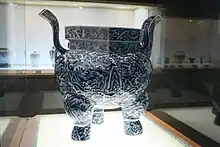
The Xuande Emperor was known as an accomplished painter, particularly skilled at painting animals. Some of his art work is preserved in the National Palace Museum, Taipei and formerly in the Arthur M. Sackler Museum (a division of Harvard Art Museum) in Cambridge, Massachusetts. Robert D. Mowry, the curator of Chinese art at the Arthur M. Sackler Museum, described him as "the only Ming emperor who displayed genuine artistic talent and interest."[6]
The period of the Xuande Emperor (1426–1435) is often considered one of the most sophisticated periods in the history of Chinese Blue and White porcelain crafts.[7]
 Gibbons at play (戲猿圖; 1427), National Palace Museum, Taipei, Taiwan
Gibbons at play (戲猿圖; 1427), National Palace Museum, Taipei, Taiwan Mouse and Stone (苦瓜鼠圖; 1427), The Palace Museum, Beijing
Mouse and Stone (苦瓜鼠圖; 1427), The Palace Museum, Beijing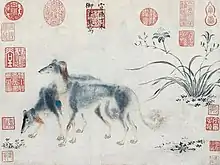 Two Saluki Hounds (猎犬圖; 1427), Harvard Art Museum, United States
Two Saluki Hounds (猎犬圖; 1427), Harvard Art Museum, United States![Three Yang [Goats], an Auspicious Start (to the New Year) (三陽開泰; 1429), National Palace Museum](../I/%E6%98%8E_%E6%9C%B1%E7%9E%BB%E5%9F%BA_%E4%B8%89%E9%98%B3%E5%BC%80%E6%B3%B0%E8%BD%B4.jpg.webp) Three Yang [Goats], an Auspicious Start (to the New Year) (三陽開泰; 1429), National Palace Museum
Three Yang [Goats], an Auspicious Start (to the New Year) (三陽開泰; 1429), National Palace Museum 《御臨黃筌花鳥》National Palace Museum
《御臨黃筌花鳥》National Palace Museum Marquis Wu in Repose (武侯高臥圖), The Palace Museum
Marquis Wu in Repose (武侯高臥圖), The Palace Museum_imperial_blue_and_white_vase%252C_from_The_Metropolitan_Museum_of_Art._%E6%98%8E%E5%AE%A3%E5%BE%B7_%E6%99%AF%E5%BE%B7%E9%8E%AE%E7%AA%AF%E9%9D%92%E8%8A%B1%E8%B2%AB%E8%80%B3%E7%93%B6%252C_%E7%BA%BD%E7%BA%A6%E5%A4%A7%E9%83%BD%E5%8D%9A%E7%89%A9%E9%A6%86_.jpg.webp) Ming dynasty Xuande mark and period (1426–35) imperial blue and white vase. The Metropolitan Museum of Art, New York.
Ming dynasty Xuande mark and period (1426–35) imperial blue and white vase. The Metropolitan Museum of Art, New York.
Portrayal in art
Family
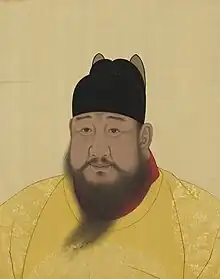
Consorts and Issue:
- Empress Gongrangzhang, of the Hu clan (恭讓章皇后 胡氏; 20 May 1402 – 5 December 1443), personal name Shanxiang (善祥)
- Princess Shunde (順德公主; 1420–1443), first daughter
- Married Shi Jing (石璟; 9 January 1420 – 17 October 1479) in 1437
- Princess Yongqing (永清公主; d. 1433), second daughter
- Princess Shunde (順德公主; 1420–1443), first daughter
- Empress Xiaogongzhang, of the Sun clan (孝恭章皇后 孫氏; 1399 – 26 September 1462)
- Princess Changde (常德公主; 1424–1470), third daughter
- Married Xue Huan (薛桓) in 1440
- Zhu Qizhen, Emperor Yingzong (英宗 朱祁鎮; 29 November 1427 – 23 February 1464), first son
- Princess Changde (常德公主; 1424–1470), third daughter
- Consort Rongsixian, of the Wu clan (榮思賢妃 吳氏; 1397 – 16 January 1462)
- Zhu Qiyu, the Jingtai Emperor (景泰帝 朱祁鈺; 21 September 1428 – 14 March 1457), second son
- Noble Consort Duanjing, of the He clan (端靜貴妃 何氏; d. 1435)
- Consort Chunjingxian, of the Zhao clan (純靜賢妃 趙氏; d. 1435)
- Consort Zhenshunhui, of the Wu clan (貞順惠妃 吳氏; d. 1435)
- Consort Zhuangjingshu, of the Jiao clan (莊靜淑妃 焦氏; d. 1435)
- Consort Zhuangshunjing, of the Cao clan (莊順敬妃 曹氏; d. 1435)
- Consort Zhenhuishun, of the Xu clan (貞惠順妃 徐氏; d. 1435)
- Consort Gongdingli, of the Yuan clan (恭定麗妃 袁氏; d. 1435)
- Consort Zhenjinggong, of the Zhu clan (貞靜恭妃 諸氏; d. 1435)
- Consort Gongshunchong, of the Li clan (恭順充妃 李氏; d. 1435)
- Consort Suxicheng, of the He clan (肅僖成妃 何氏; d. 1435)
- Consort Shu, of the Liu clan (淑妃 劉氏)
- Concubine Zhen'aiguo, of the Guo clan (貞哀國嬪 郭氏; d. 1435), personal name Ai (愛)
- Lady Gongshen, of the Korean Cheongju Han clan (恭愼夫人 清州韓氏; 9 April 1410 – 18 May 1483), personal name Gye-ran (桂蘭)[lower-alpha 1]
Ancestry
| Zhu Shizhen (1281–1344) | |||||||||||||||||||
| Hongwu Emperor (1328–1398) | |||||||||||||||||||
| Empress Chun (1286–1344) | |||||||||||||||||||
| Yongle Emperor (1360–1424) | |||||||||||||||||||
| Empress Xiaocigao (1332–1382) | |||||||||||||||||||
| Lady Zheng | |||||||||||||||||||
| Hongxi Emperor (1378–1425) | |||||||||||||||||||
| Xu Liusi | |||||||||||||||||||
| Xu Da (1332–1385) | |||||||||||||||||||
| Lady Cai | |||||||||||||||||||
| Empress Renxiaowen (1362–1407) | |||||||||||||||||||
| Xie Zaixing | |||||||||||||||||||
| Lady Xie | |||||||||||||||||||
| Xuande Emperor (1399–1435) | |||||||||||||||||||
| Zhang Jinghui | |||||||||||||||||||
| Zhang Congyi | |||||||||||||||||||
| Lady Liu | |||||||||||||||||||
| Zhang Qi | |||||||||||||||||||
| Lady Zhu | |||||||||||||||||||
| Empress Chengxiaozhao (1379–1442) | |||||||||||||||||||
| Tong Shan | |||||||||||||||||||
| Lady Tong | |||||||||||||||||||
Popular culture
- Portrayed by Zhu Yawen in the 2019 Hunan TV series Ming Dynasty
- Portrayed by Xu Kai in the 2022 Hunan/Mango TV series Royal Feast "尚食".
See also
Notes
- Her eldest sister was Consort Kanghuizhuangshuli, a concubine of the Yongle Emperor; while her niece was Queen Sohye, the mother of King Seongjong of Joseon.
References
- 《宣宗章皇帝實錄》. "仁宗昭皇帝嫡長子,母今太皇太后,以己卯歲二月九日生上於北京。" (in Chinese)
- Keith Taylor (2014). A History of the Vietnamese. Cambridge University Press. pp. 180–184. ISBN 9780521699150.
- "本紀第九 宣宗". 明史 [History of Ming]. Vol. 9 – via Wikisource.
- Kerr, George (1958). Okinawa: History of an Island People. Tokyo: Charles E. Tuttle Company. p. 90.
- Frederick W. Mote (1999). Imperial China, 900-1800. Harvard University Press. p. 626. ISBN 9780674012127.
- "Imperial Salukis: Speedy hounds, portrayed by a Chinese emperor". Harvard Magazine, May–June 2007.
- Yi Ching, Leung. "2016 Top 20 Chinese porcelain auctions (Sotheby's/ Christie's)". www.zentopia-culture.com/. Leung Yi Ching. Retrieved 15 January 2017.
Sources
- Chan, Hok-lam (1988). "The Chien-wen, Yung-lo, Hung-hsi, and Hsüan-te reigns, 1399–1435". In Mote, Frederick W.; Twitchett, Denis (eds.). The Cambridge History of China. pp. 285–304. doi:10.1017/CHOL9780521243322.006. ISBN 9781139054751.
Further reading
- Dreyer, Edward L. (1982). Early Ming China : a political history, 1355-1435. Stanford University Press. ISBN 9780804711050.
- "Chinese Government in Ming Times" by Charles Hucker (1969).
